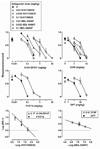Effects of serotonin (5-HT)1A and 5-HT2A receptor agonists on schedule-controlled responding in rats: drug combination studies
- PMID: 21174080
- PMCID: PMC4144073
- DOI: 10.1007/s00213-010-2136-9
Effects of serotonin (5-HT)1A and 5-HT2A receptor agonists on schedule-controlled responding in rats: drug combination studies
Abstract
Rationale: Indirect-acting serotonin (5-HT) receptor agonists (e.g., selective 5-HT reuptake inhibitors [SSRI]) stimulate multiple 5-HT receptors, although the role of particular receptors as well as interaction(s) among different receptors in the therapeutic effects of SSRIs is not fully understood.
Objectives: Relatively few studies have systematically examined direct-acting agonists in combination. This study examined the 5-HT(1A) receptor agonists 8-hydroxy-2-(di-n-propylamino) tetralin hydrochloride (8-OH-DPAT; 0.01-10.0 mg/kg) and 3-chloro-4-fluorophenyl-4-fluoro-4-([(5-methyl-6-methylamino-pyridin-2-ylmethyl)-amino]-methyl)-piperidin-1-yl-methanone (F13714; 0.01-1.0 mg/kg) and the 5-HT(2A) receptor agonists 1-(2,5-dimethoxy-4-methylphenyl)-2-aminopropane (DOM; 0.32-10.0 mg/kg) and dipropyltryptamine (DPT; 1.0-32.0 mg/kg), alone and in combination, in rats responding under a fixed ratio schedule of food presentation.
Results: When administered alone, each drug decreased the rate of responding in a dose-related manner with the potency order being F13714 > 8-OH-DPAT > DOM > DPT. WAY100635 (5-HT(1A) receptor antagonist; 0.01-0.1 mg/kg) attenuated the rate-decreasing effects of 8-OH-DPAT and F13714 while MDL100907 (5-HT(2A) receptor antagonist; 0.01-0.1 mg/kg) attenuated the rate-decreasing effects of DOM and DPT. Dose addition analysis showed that the interaction between 8-OH-DPAT and F13714, as well as the interaction between DOM and DPT, was additive. In contrast, the interaction between 8-OH-DPAT and DOM, as well as the interaction between F13714 and DOM, was infra-additive.
Conclusions: This study shows that for some dose combinations, agonist actions at one 5-HT receptor subtype attenuate agonist actions at another 5-HT receptor subtype; thus, the combined neuropharmacological actions and therapeutic effects of indirect-acting agonists are not likely to be adequately characterized by examining in isolation activity at particular 5-HT receptor subtypes.
Conflict of interest statement
The authors have no conflicts of interest to declare
Figures




Similar articles
-
Differential effects of serotonin 5-HT1A receptor agonists on the discriminative stimulus effects of the 5-HT2A receptor agonist 1-(2,5-dimethoxy-4-methylphenyl)-2-aminopropane in rats and rhesus monkeys.J Pharmacol Exp Ther. 2010 Apr;333(1):244-52. doi: 10.1124/jpet.109.163451. Epub 2010 Jan 6. J Pharmacol Exp Ther. 2010. PMID: 20053932 Free PMC article.
-
Modification of the behavioral effects of morphine in rats by serotonin 5-HT₁A and 5-HT₂A receptor agonists: antinociception, drug discrimination, and locomotor activity.Psychopharmacology (Berl). 2013 Feb;225(4):791-801. doi: 10.1007/s00213-012-2870-2. Epub 2012 Sep 20. Psychopharmacology (Berl). 2013. PMID: 22993050 Free PMC article.
-
Discriminative stimulus effects of 1-(2,5-dimethoxy-4-methylphenyl)-2-aminopropane in rhesus monkeys: antagonism and apparent pA2 analyses.J Pharmacol Exp Ther. 2009 Mar;328(3):976-81. doi: 10.1124/jpet.108.145458. Epub 2008 Dec 19. J Pharmacol Exp Ther. 2009. PMID: 19098164 Free PMC article.
-
Behavioral effects of dipropyltryptamine in rats: evidence for 5-HT1A and 5-HT2A agonist activity.Behav Pharmacol. 2007 Jul;18(4):283-8. doi: 10.1097/FBP.0b013e3281f19ca0. Behav Pharmacol. 2007. PMID: 17551320
-
3-Chloro-4-[18F]fluorophenyl-(4-fluoro-4-[[((5-methyl-4-methylamino-pyridin-2-ylmethyl)-amino]-methyl]-piperidin-1-yl)methanone (F13714).2012 Jun 24 [updated 2012 Oct 11]. In: Molecular Imaging and Contrast Agent Database (MICAD) [Internet]. Bethesda (MD): National Center for Biotechnology Information (US); 2004–2013. 2012 Jun 24 [updated 2012 Oct 11]. In: Molecular Imaging and Contrast Agent Database (MICAD) [Internet]. Bethesda (MD): National Center for Biotechnology Information (US); 2004–2013. PMID: 23077752 Free Books & Documents. Review.
Cited by
-
Antinociceptive Interactions between the Imidazoline I2 Receptor Agonist 2-BFI and Opioids in Rats: Role of Efficacy at the μ-Opioid Receptor.J Pharmacol Exp Ther. 2016 Jun;357(3):509-19. doi: 10.1124/jpet.116.232421. Epub 2016 Apr 7. J Pharmacol Exp Ther. 2016. PMID: 27056847 Free PMC article.
-
Inhibition of Cocaine and 3,4-Methylenedioxypyrovalerone (MDPV) Self-Administration by Lorcaserin Is Mediated by 5-HT2C Receptors in Rats.J Pharmacol Exp Ther. 2018 Mar;364(2):359-366. doi: 10.1124/jpet.117.246082. Epub 2017 Dec 7. J Pharmacol Exp Ther. 2018. PMID: 29217539 Free PMC article.
-
Interactions between imidazoline I2 receptor ligands and acetaminophen in adult male rats: antinociception and schedule-controlled responding.Psychopharmacology (Berl). 2016 Mar;233(5):873-82. doi: 10.1007/s00213-015-4166-9. Epub 2015 Nov 28. Psychopharmacology (Berl). 2016. PMID: 26613734 Free PMC article.
-
Receptor binding profiles and behavioral pharmacology of ring-substituted N,N-diallyltryptamine analogs.Neuropharmacology. 2018 Nov;142:231-239. doi: 10.1016/j.neuropharm.2018.02.028. Epub 2018 Feb 27. Neuropharmacology. 2018. PMID: 29499272 Free PMC article.
-
Characterization of the hypothermic effects of imidazoline I₂ receptor agonists in rats.Br J Pharmacol. 2012 Jul;166(6):1936-45. doi: 10.1111/j.1476-5381.2012.01894.x. Br J Pharmacol. 2012. PMID: 22324428 Free PMC article.
References
-
- Arnt J, Hyttel J. Facilitation of 8-OH-DPAT-induced forepaw treading of rats by the 5-HT2agonist DOI. Eur J Pharmacol. 1989;161:45–51. - PubMed
-
- Carter LP, Flores LR, Wu H, Chen W, Unzeitig AW, Coop A, France CP. The role of GABABreceptors in the discriminative stimulus effects of gamma-hydroxybutyrate in rats: time course and antagonism studies. J Pharmacol Exp Ther. 2003;305:668–674. - PubMed
-
- Darmani NA, Martin BR, Pandey U, Glennon RA. Do functional relationships exist between 5-HT1Aand 5-HT2receptors? Pharmacol Biochem Behav. 1989;36:901–906. - PubMed
Publication types
MeSH terms
Substances
Grants and funding
LinkOut - more resources
Full Text Sources

